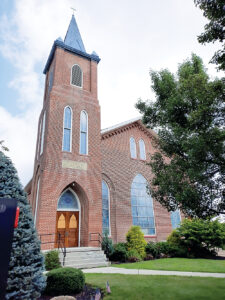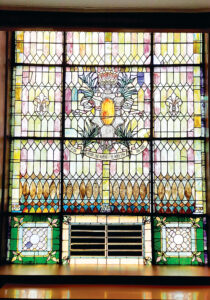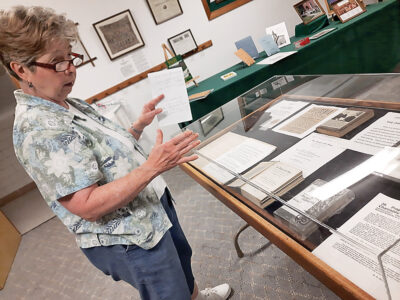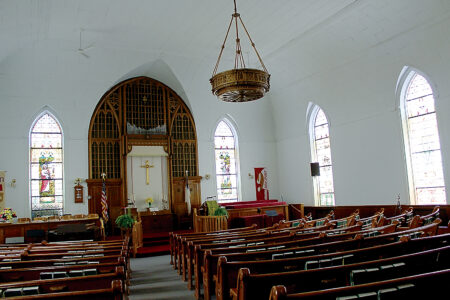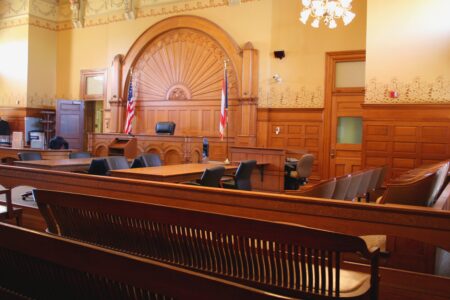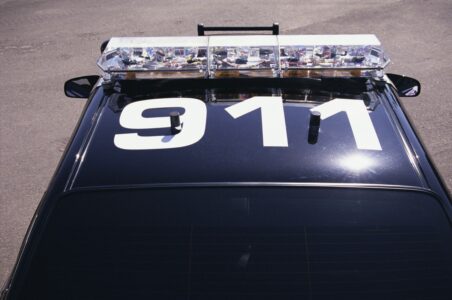Etched in History: Ebensburg’s First Church celebrates 225 years
- Ebensburg’s First United Church of Christ is celebrating 225 years in the borough and is considered the oldest Welsh Congregational Church in the United States. Mirror photo by Holly Claycomb
- Ebensburg’s First United Church of Christ is raising money to restore its stained glass windows. Mirror photo by Holly Claycomb
- First United Church of Christ member Kathy Jones discusses church history amid a display of church records. Mirror photo by Holly Claycomb
- First United Church of Christ in Ebensburg will celebrate its 225th anniversary with events this weekend. Mirror photo by Holly Claycomb
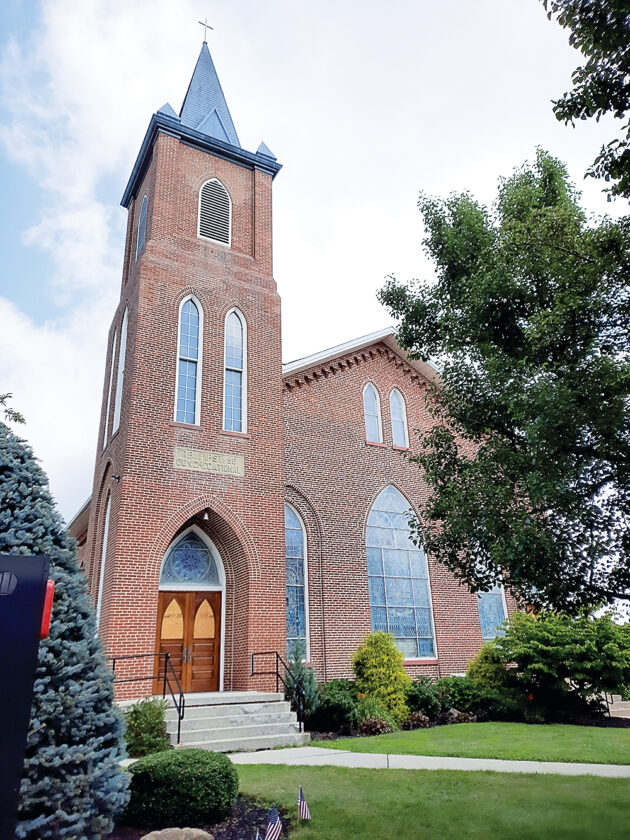
Ebensburg’s First United Church of Christ is celebrating 225 years in the borough and is considered the oldest Welsh Congregational Church in the United States. Mirror photo by Holly Claycomb
EBENSBURG — The Welsh language, while admittedly filled with what looks to be too many consonants, is lyrical and beautiful, Kathy Jones said.
Except maybe when the congregation of the First United Church of Christ tries to sing hymns in the language of the church’s founders, she added with a good-natured laugh, having tried to sing in Welsh herself.
The church, which has stood the test of time and whose early home once housed the Cambria County Court of Common Pleas, will celebrate its humble beginnings Sunday as the congregation marks its 225th anniversary during a 10 a.m. worship service. A cake and ice cream social will be held from 2 to 4 p.m. The train set up, usually open during Ebensburg’s Dickens of a Christmas celebration, will also be operating.
The events coincide with Ebensburg’s annual homecoming celebration, although the church is a bit older, Jones said.
Ebensburg’s history is tied closely to the Welsh, as it is the first permanent settlement on the Allegheny Front, according to borough records, which list Ebensburg as being founded in 1797.
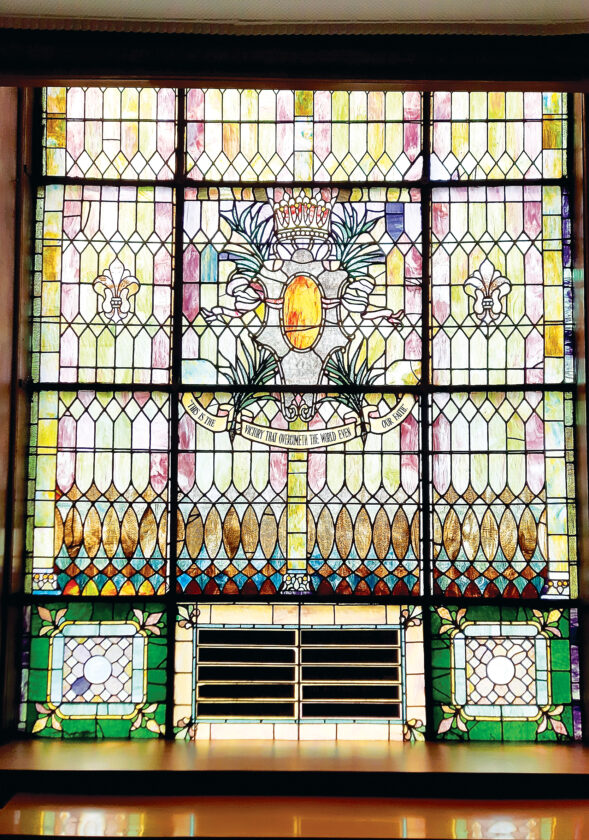
Ebensburg's First United Church of Christ is raising money to restore its stained glass windows. Mirror photo by Holly Claycomb
The church’s history dates to April 1797, when the First Congregational Church of Ebensburg — or the Welsh Independent Church as it was known then — was founded, according to information compiled by the Rev. William Thwing, who retired from the pulpit at First United more than a decade ago. Thwing will return to the pulpit for Sunday’s celebration, giving current lay speaker Andy Jones a break.
Today’s church building, along High Street, is actually its fourth.
The original 24 members met in a “very crude” log building that measured 20 feet square, records state, and it was located near what is now the Lloyd Cemetery, named for the Rev. Rees Lloyd, the church’s first pastor and founder of Ebensburg. Lloyd was born in Llanboidy, Carmarthenshire, Wales, in 1759, ordained at Ebenezer chapel, Pontypool, Monmouthshire, Wales, in 1795, and emigrated that same year with his family and other Welsh citizens to the United States.
The group ended up in Philadelphia, church member Kathy Jones said, and Lloyd and his family then traveled west. They settled in what is now known as Ebensburg on Nov. 19, 1796. Other Welsh settlers came and branched off to nearby areas, including a group led by the Rev. Morgan John Rhys in the summer of 1797. That group established Beulah.
Lloyd founded the first church in what today is Cambria County. The church is considered the oldest Welsh Congregational Church in the United States.
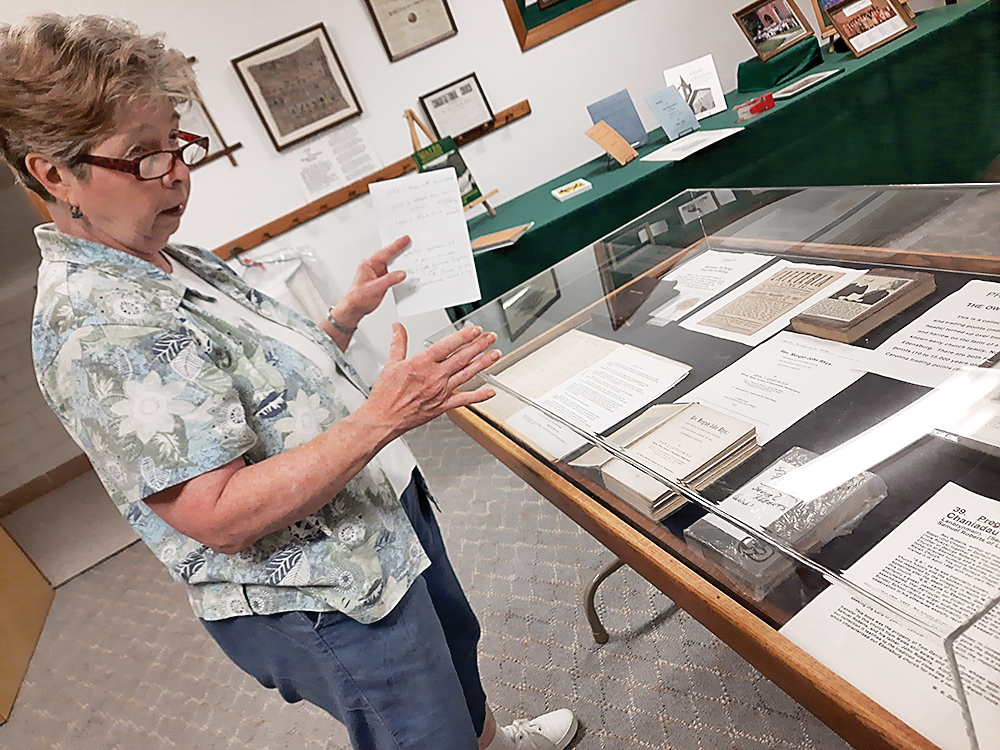
First United Church of Christ member Kathy Jones discusses church history amid a display of church records. Mirror photo by Holly Claycomb
Lloyd is also credited with naming Ebensburg, and there are several theories on the name — it may have been named for the chapel where Lloyd was ordained, or after his son Ebenerer, who died in infancy, or from the Bible passage found in 1 Samuel 4-7: “Here I raise by Ebenezer.”
Rootsweb.com states the borough is named for the son. The name stuck around, as did the hardworking Welsh people, said 80-year-old church member Barry Templeton.
“They’re tough,” Templeton said. “If you had Welsh parents, grandparents … you walked the line.”
As more people settled in the area, the church grew, and in 1804, a new meeting house was built on the site of what is now the church’s educational building.
Church used for court
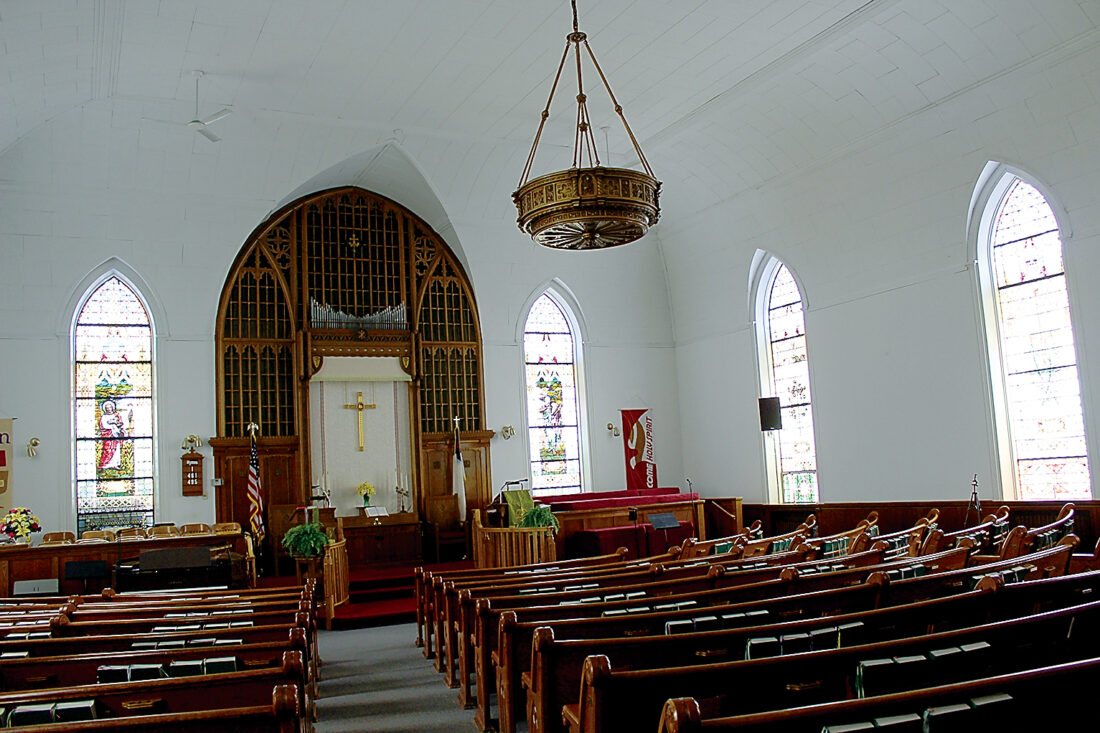
First United Church of Christ in Ebensburg will celebrate its 225th anniversary with events this weekend. Mirror photo by Holly Claycomb
That same year, on March 26, Cambria County was formed out of Huntingdon and Somerset counties, and the new two-story log church took on a double life — that of a church and a courtroom.
According to church history, the church building on Sample Street was the largest log structure in Ebensburg. The second floor was rented to Cambria County for $10 a year, said Jones, and the first sessions of the Court of Common Pleas were held there. The only known photo of the building shows it in later years, after it had been used as a stable.
“It became a stable when the next church was built,” she explained.
After the county was established, Ebensburg was selected as the county seat, a feat also credited to Lloyd, who reportedly donated 104 acres of land for the public buildings and other uses.
Also in the running to be the county seat were Munster and Beulah, and while Munster Township remains, Beulah ceased to exist in 1804. All that is left of the village is Beulah Cemetery and Beulah Road.
The third church building, erected in 1832, was known as the “Old Brick Church” and served the congregation until the present church building was constructed in 1869. The bell tower and the finishing touch — the stained glass windows — were added nearly 30 years later in 1896, when the church was renovated.
An educational building was added in 1959, when the church had large numbers of children during the baby boom of the ’50s and ’60s.
“There were 30 to 40 kids in Sunday school,” Templeton said.
A few years later, the old parsonage that stood next to the church was razed and a new parsonage was built in Crestwood, Jones said.
The old parsonage was removed because the Rev. Ed Jenkens lived there at a time when no roads bypassed Ebensburg, Jones said, and many people walked through town.
“He would get so many people knocking on his door day and night,” she said. So many people stopped, Jones said, that safety became an issue and the decision was made to move the parsonage away from the church.
While the first, second and third church buildings no longer exist, the bricks from the third church were used to construct a home that still stands today, Jones added.
Dropping Welsh for English
As the church transitioned to various buildings, there were also changes within the makeup of the congregation. Many current church members can trace their roots back to the Welsh, but the language has been mostly lost in the area, Templeton said.
Welsh was spoken exclusively until 1850. Though after some members left to attend the newly established English-speaking Presbyterian church, leadership felt it necessary “to give a little English,” according to Thwing’s writings.
Beginning in 1875, morning services were held alternatively in Welsh and English, and by 1886, the congregation decided to hold all services in English.
“There are still some Welsh in our church,” Templeton said. “Though not as many as there used to be.”
The church continues to sing Welsh songs — in English, he said, adding that both his grandmother and grandfather could speak Welsh, but he only knows “a little bit.”
St. David’s Day, named for the patron saint of Wales, continues to be celebrated on the first Sunday of March, Jones said, noting the actual day is March 1.
During those services, the congregation will also sing the Welsh anthem, again in English, unless a special speaker or music director is available to lead the singing.
“We’ve had some people who came here who could sing and speak it,” Templeton said.
Challenging times
There are nearly a dozen churches in Ebensburg today, Jones said, and that has led to a drop in attendance. When the pandemic hit, that added to the challenge, Jones and Templeton said.
Each building project was undertaken because the church was growing, but today, the educational building is no longer used for Sunday school, as there aren’t enough kids who attend, Templeton said.
The building houses the pastor’s and secretary’s offices, as well as meeting rooms that are available for rent. There is also a full kitchen, Jones said, noting the church is known for its turkey biscuit dinners that are normally served twice a year — in April and October. Those dinners would see the church serving 800 to 950 dinners, she said, but they have been on hold due to the pandemic.
Despite a name change to the First United Church of Christ, “old-timers” know it as the Welsh church or “the Congo,” for its origins as the Congregational Church, Templeton said.
But there are “not too many old-timers left,” he said.
“Age has taken numerous people out of our congregation,” he said, and “young people seem too busy.”
Templeton said the church seats 300 people, and the back three wall sections slide up into the roof to accommodate more.
“But we’re getting very few on Sundays,” he lamented. “We were getting 50 to 100 before COVID. … We’ve had an awful time getting them back.”
Between 25 and 35 people attend Sunday services now, he said. The church livestreams the service, so he’s hopeful others are tuning in.
Those who attend regularly are hopeful, too, that as the pandemic wanes, more people will take notice of a new contemporary service the church will offer and attendance will rise.
“We have a group who are trying to really do some things,” Templeton said.
The contemporary services will start in August on Saturday evenings. Since it’s a new style of service, they’re getting some assistance from another church.
“That’s something new,” Templeton said. “There’s still a lot of the old Welsh thinking and old-timers’ ideas.”
He hopes that doesn’t deter people from seeing what it’s all about.
While the church has faced some setbacks, he believes the church will continue for many years.
“I credit that to the 25 to 40 people who come to church on Sunday and want it to be there,” he said. “We’re working our darnedest to keep it.”
‘Come see the windows’
One major draw for visitors is its Rudy Bros. stained glass windows.
The windows cost $1,021.50 when they were installed in 1896, Jones said, after finding the bill while looking through church records.
The church is currently raising money to have them restored by Cambria Glass. Two have been completed and reinstalled; a third will be heading out after the Sunday celebration. They will cost over $30,000 each to restore.
Jones, who spent 14 years with the Cambria County Historical Society, is currently researching “the people in the windows,” as memorial tributes are included within the artwork.
The windows show off the talents of the Rudy Brothers, who came to Pittsburgh in 1893 to make stained glass windows for the H.J. Heinz factory and his Point Breeze home, Jones said.
They found success designing windows for churches, mausoleums and private homes and continued until the Great Depression. The last brother, Isaiah, the youngest, continued the business on a much smaller scale until his death in 1962.
Another feature that Jones didn’t notice until it was pointed out to her is the stippling or artificial graining that is on nearly all the wood inside the church — including the three huge partitions that slide up into the ceiling.
Jones was told by a church member that the graining technique is “one of the real treasures” of the church.
Also, according to that same church member, the late Dick Davis, dynamite was used to excavate under the church, as it was built without a basement. Davis told Jones that kids were sent to the hardware store to purchase the dynamite for the project.
Davis’ work translating 100 years of Welsh records for the church can be found in the history room in the education building, which will also be open for Sunday’s festivities.
Church members said they hope people come out for the celebration, check out the church and its prominent history in Ebensburg and Cambria County and stay for ice cream and cake.
As for the windows, they’re encased in the safety glass on the outside, so Templeton said everyone should “come to the service and see them from the inside.”

